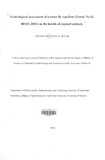| dc.description.abstract | Tsetse and trypanosomosis have been extensively studied and an array of vector and
disease control measures have been developed and applied with varying degrees of
success. Current trypanosomosis control strategies rely on use of trypanocidal drugs,
breeding of trypanotolerant cattle and tsetse control or eradication. Since none of these
control options has proved to be a fully viable solution to the control of trypanosomosis,
search for more tsetse fly and trypanosomosis control measures continues.
A synthetic tsetse fly repellent (patent No. Ke 00185, 2004; Saini and Hassanali), was
identified in 1999 at the International Center for Insect Physiology and Ecology
(ICIPE). The repellent is based on the potent phenolic analogue of a mild natural
repellent of Savannah tsetse fly species. This single- component synthetic compound
was discovered from a structure-activity study of the phenolic constituents of body
odors of tsetse bovid hosts and their aged urine. Preliminary field trials undertaken
among the pastoralist community in Nguruman Kenya, showed that the repellent caused
more than 80% reduction in tsetse challenge and reduced the feeding efficiency of the
tsetse fly on cattle by over 90%. This research technology needs to be packaged, ready
for release and transfer to livestock farmers in tsetse fly infested areas.
No chemical agent is entirely safe and likewise no chemical agent should be considered
as being entirely harmfuL This concept is based on the premise that any chemical can be
permitted to come into contact with a biologic mechanism without producing an effect on
that mechanism provided the concentration of the chemical is below the toxic leveL This
study was therefore undertaken to generate data on acute toxicity of the repellent in
laboratory mice and effects of prolonged exposure to vapours of the repellent in goats as
a prelude to its potential utilization for tsetse fly control in livestock. Data obtained from
the acute toxicity studies in mice may be extrapolated to reflect the toxicity of the
repellent to domestic animals and humans. In another experiment, rabbits were used to
determine the ocular and dermal irritant effects of the repellent. Haematological and
biochemical effects of the repellent were determined in goats exposed to low -2mg/hr and
high doses -4mg/hr of the vapours of the repellent through repellent collars for nine
months. After the nine months of exposure to the repellent, two goats from the low dose,
high dose and the control group each were sacrificed and the chronic pathologic effects of
the repellent determined using standard histopathology techniques.
The 24 hours intraperitoneal (i.p) median lethal dose (LD5o) of the repellent in mice
was found to be 40.2mg/kg body weight. The clinical signs of acute toxicity were
decreased locomotor activity, an initial increase followed by a decrease in respiratory
rate and an increased depth in respiration, terminal convulsions, coma and death. Death
was probably due to depression and paralysis of the respiratory center in the brain. The
repellent caused mild dermal irritation characterized by edema and erythema. There
was moderate eye irritation affecting the cornea, iris and conjunctiva. Plasma levels of
gamma glutamyl transpeptidase (GGT), alkaline phosphatase (ALP) and aspartate
aminotransferase (AST) were monitored monthly for nine months. There were no
significant differences between the treated and the control animals in the plasma levels
of the enzymes over the experimental period (p >0.05). For hematological parameters,
the monthly means in all the groups for the RBC count were within the normal range
for the species. There were also no significant differences between the means of the
three groups (p>0.05). There was variation in the mean monthly values of the
granulocyte and lymphocyte count that was not associated with the treatment since the
trend was similar in both the treated and the control groups. The monthly group means
for the WBC count were above the reference values for the species in all the groups
including the pre-treatment values. There were no significant differences in the monthly
means of the WBC count between the treated and the control group (p>0.05). Similarly,
there was no significant difference in mean body weight between the treated and the
control groups of the goats (p> 0.05). Histological sections prepared from the lungs,
liver, kidney and heart tissues showed normal cellular and organ structure except for
mild lymphocyte infiltration in the lung tissue in all the groups.
According to the standard scheme for classifying relative toxicities, the LD50 in mice
indicates that the synthetic repellent is highly toxic, manifesting central nervous system
(CNS) effects. Ingestion of the repellent should, therefore, be avoided. The repellent is
a mild skin irritant and causes eye irritation. However, the vapours of the repellent
caused no effects on haematological and biochemical parameters and general health of
exposed goats over the experimental period. Although the reactions in mice, rabbits and
goats may not necessarily be the same as in humans, from the results, it is
recommended that the tsetse fly repellent should be handled properly to avoid skin and
eye contacts of the animal and the.handlers. Clear information on the toxicity should be
availed to the animal handlers. Any accidental contact would be treated
symptomatically. | en |

